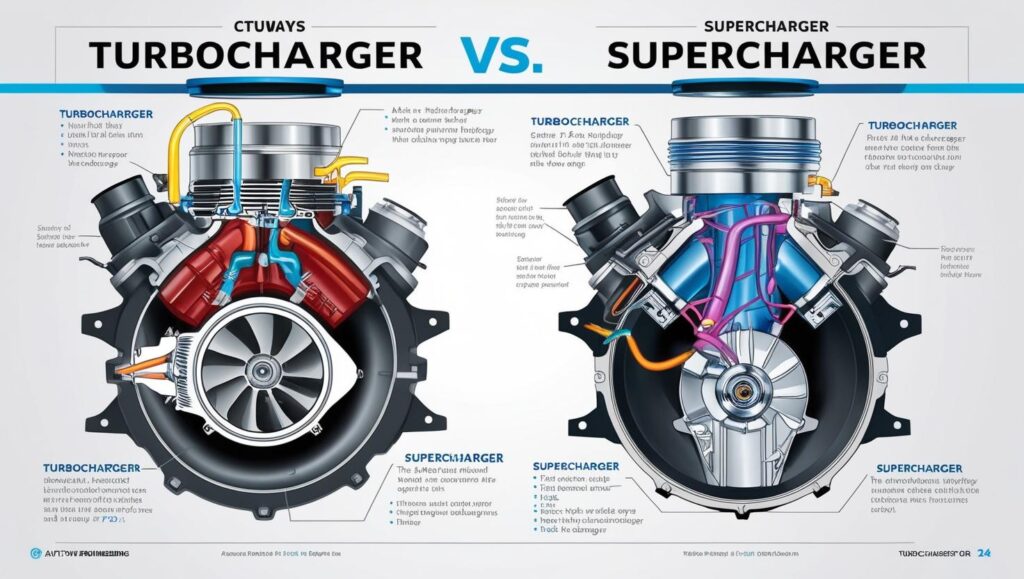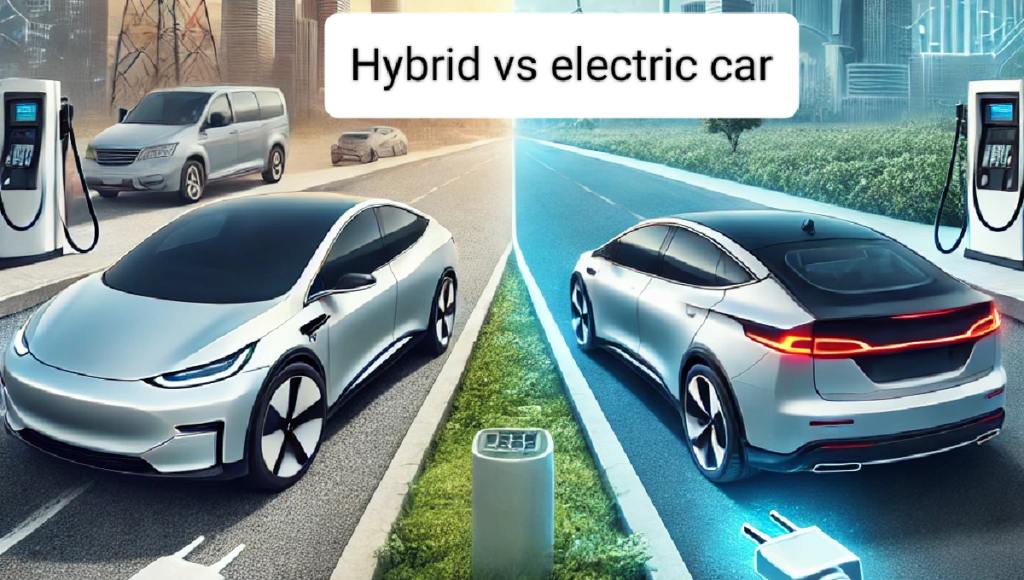
Table of Contents
1. Introduction: Turbochargers vs Superchargers
Forced induction is a method used in internal combustion engines to increase power output by compressing the air entering the engine. The two main types of forced induction are turbochargers and superchargers. Both work on similar principles but have fundamental differences in power delivery, efficiency, and application.
| Comparison Factor | Turbocharger | Supercharger |
|---|---|---|
| Power Source | Exhaust gases | Engine-driven belt |
| Efficiency | More efficient | Less efficient |
| Lag | Turbo lag present | Immediate power |
| Complexity | More complex | Simpler design |
| Maintenance | Higher | Lower |
2. How Turbochargers Work
A turbocharger uses exhaust gases from the engine to spin a turbine, which in turn drives a compressor that forces more air into the engine. This increased airflow allows the engine to burn more fuel and produce more power without increasing engine displacement.
| Component | Function |
|---|---|
| Turbine | Spins using exhaust gases |
| Compressor | Pressurizes intake air |
| Intercooler | Cools compressed air |
| Wastegate | Regulates boost pressure |
Turbochargers improve fuel efficiency by utilizing waste energy from the exhaust. However, they suffer from turbo lag, which is a delay in power delivery due to the time taken for the turbine to spin up.
3. How Superchargers Work
A supercharger is mechanically driven by the engine, typically via a belt connected to the crankshaft. This direct connection eliminates turbo lag and provides instant power delivery.
| Type of Supercharger | Working Principle |
|---|---|
| Centrifugal Supercharger | Uses a rotating impeller to compress air |
| Roots Supercharger | Uses lobes to force air into the engine |
| Twin-Screw Supercharger | Compresses air between interlocking screws |
Superchargers provide instant throttle response, making them ideal for performance applications. However, they consume engine power, reducing overall efficiency.
4. Power Delivery: Turbochargers vs Superchargers
The main difference in power delivery is how and when the boost is generated.
| Factor | Turbocharger | Supercharger |
|---|---|---|
| Power Delivery | Delayed due to turbo lag | Immediate |
| Boost at Low RPM | Low | High |
| Boost at High RPM | High | Consistent |
A turbocharger builds boost gradually, making it ideal for applications where high-end power is needed. A supercharger delivers consistent power, making it useful for racing and high-performance driving.
5. Efficiency and Fuel Consumption
Efficiency plays a crucial role in forced induction. Turbochargers are generally more fuel-efficient because they utilize waste energy from exhaust gases.
| Efficiency Factor | Turbocharger | Supercharger |
|---|---|---|
| Fuel Efficiency | Higher | Lower |
| Energy Source | Exhaust gases | Engine-driven |
| Heat Generation | More | Less |
A supercharger increases engine load, consuming more fuel in the process, whereas a turbocharger extracts power from wasted energy, making it more efficient.

6. Reliability and Maintenance
Both systems require maintenance, but turbochargers tend to need more frequent servicing due to their complexity and heat generation.
| Reliability Factor | Turbocharger | Supercharger |
|---|---|---|
| Complexity | High | Low |
| Heat Generation | More | Less |
| Maintenance Cost | Higher | Lower |
Turbochargers operate at extremely high speeds and temperatures, leading to increased wear and tear. Superchargers, being mechanically driven, are simpler and tend to be more durable.
7. Application in Automobiles
Turbochargers and superchargers are used in different types of vehicles, depending on the desired performance characteristics.
| Vehicle Type | Preferred Induction | Reason |
|---|---|---|
| Sports Cars | Supercharger | Instant power |
| Performance Cars | Turbocharger | High-end power |
| Trucks & SUVs | Turbocharger | Better fuel efficiency |
| Muscle Cars | Supercharger | Traditional power boost |
Turbochargers are commonly used in modern fuel-efficient cars and high-performance vehicles, whereas superchargers are more common in muscle cars and racing applications.

8. Cost and Aftermarket Upgrades
Cost is a significant factor when choosing between turbochargers and superchargers.
| Cost Factor | Turbocharger | Supercharger |
|---|---|---|
| Initial Cost | Higher | Lower |
| Installation | More complex | Easier |
| Aftermarket Tuning | Extensive | Limited |
Turbochargers are expensive and complex to install but offer greater tuning potential. Superchargers are simpler but have limited upgrade options.
9. Environmental Impact
Environmental concerns play a role in selecting forced induction systems.
| Environmental Factor | Turbocharger | Supercharger |
|---|---|---|
| Emissions Reduction | Yes | No |
| Fuel Consumption | Lower | Higher |
| Noise Levels | Higher | Lower |
Turbochargers contribute to lower emissions by improving efficiency, making them more eco-friendly compared to superchargers.
10. Pros and Cons of Turbochargers and Superchargers
Pros of Turbochargers
✅ Better Fuel Efficiency – Uses exhaust gases to generate power.
✅ Higher Peak Power – Ideal for high-performance applications.
✅ Lower Emissions – More environmentally friendly.
✅ Lightweight – Does not add much weight to the engine.
Cons of Turbochargers
❌ Turbo Lag – Delay in power delivery.
❌ Complex Installation – More components and tuning required.
❌ Heat Generation – Requires additional cooling systems.
Pros of Superchargers
✅ Instant Power – No lag in throttle response.
✅ Simpler Design – Easier to install and maintain.
✅ Consistent Boost – Delivers power throughout the RPM range.
Cons of Superchargers
❌ Less Efficient – Consumes engine power, increasing fuel consumption.
❌ Higher Engine Load – Increases wear and tear.
❌ Limited Tuning Potential – Less flexible than turbochargers.
Final through: Which One is Better?
The choice between a turbocharger and a supercharger depends on your needs:
- For fuel efficiency and high-end power, a turbocharger is the better option.
- For immediate throttle response and consistency, a supercharger is preferred.
Ultimately, modern performance cars use turbochargers for their efficiency, whereas muscle cars and track-focused machines often rely on superchargers for instant power delivery.
Also read


